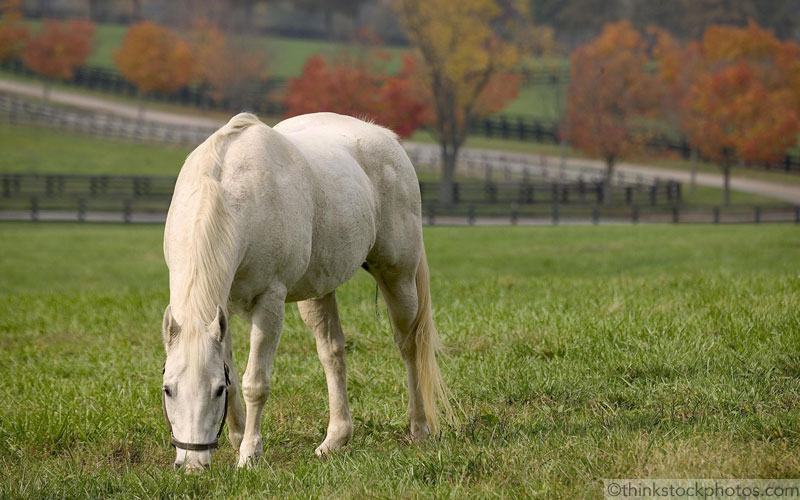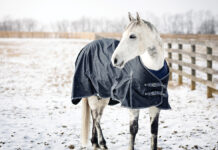
The days are most definitely getting shorter and the mornings are a bit cooler; your horse has probably already begun growing in a bit of his winter coat. The time to begin preparing for cold, wintery weather to come is now, while the weather is still bearable. Here is a horse owner fall and winter preparation checklist!
Fall/Winter Preparation Checklist – Around the farm:
- Check out run-ins in your pastures carefully to ensure they haven’t been damaged during the summer. Repair any holes in the sides or roof. Remove manure and make sure that the footing is not muddy or rutted. If it is, consider bringing in a load of gravel or sand and leveling it before fall rains and winter snows come.
- Add footing to high-traffic areas, both inside paddocks and on driveways and walkways. Gravel or sand can increase traction in wet weather and help prevent mud from forming. Be sure to check around waterers and gates, as well.
- In preparation for fall rains, tarp your manure pile (and shavings pile if applicable) now. This will help prevent runoff into ponds and streams, and keep nutrients in place, especially important if you plan to use it for compost in the spring.
- Mow your pastures one last time and consider moving horses onto sacrifice pastures to give main pasture grass a chance to produce enough leaf growth to provide winter protection.
- Service power equipment and tools used around the farm by changing oil, flushing antifreeze and tuning up engines.
- If you have a pond in the field where your horses are kept, consider moving them to another field or fencing them out of the pond before it freezes over. Horses have been known to walk onto the ice, break through and drown before being rescued.
- Buy your snow supplies such as salt, cat litter, shovels and deicers early, before there’s a run on supplies.
- If you live in an area of the country that gets heavy snow loads, consider installing snow guards on your roof are make sure they’re securely in place. These will prevent large, potentially dangerous snow slides (“roof avalanches”) and blocked and damaged gutters.
Fall/Winter Preparation Checklist – In the barn:
- Bring out your heated buckets. Hopefully you cleaned them before stashing them for the winter, but wipe them out and make sure all cords are intact and not frayed or nibbled by curious rodent teeth. Plug them in and fill them with water to check for stray voltage.
- Insulate above-ground pipes in the barn and make sure all extension cords are in proper working order.
- If your barn is equipped with gutters, clean them thoroughly and make sure the water runs off into areas of your property that are not heavily used, like paddocks or arenas.
- Service your generator, or consider purchasing one if you don’t have one already. For many farms, loss of electricity means more than just the loss of lights—it means the loss of power to pump well water, and run some types of automatic waterers and pipe-insulation tape. Horses require a large amount of water year-round, and even a temporary loss of water to the barn can become an emergency situation. For this reason alone, it’s worth considering investing in a generator before inclement weather comes.
- Make sure all equipment, both large and small, is in working order before the cold and dark really sets in. Wrap metal handles on pitchforks, rakes and other hand tools in adhesive bandage tape for better grip (and warmth!); make sure all pitchforks have all tines intact; air up tires on wheelbarrows and garden carts to ensure they travel through snow as easily as possible.
- Make sure all lights (especially outside flood lights) are working properly.
For your horse:
- Thoroughly clean and condition tack before the threat of frozen fingers sets in.
- If you have washed and waterproofed your horse blankets, shake them out and make sure no rodents have damaged them while they were stored.
- Protect oral, injectable or topical medication and salves from freezing. Either ensure that they are in a cold-protected area of your barn or take them into the house for the winter.
- Prepare your horse’s feet: If you plan on pulling shoes for the wintery weather, do it now so he has a chance to acclimate before the ground hardens. If you plan on keeping shoes on your horse, talk to your farrier about traction options, should he need it.
In addition to preparing your horse and farm, make sure your winter coats, gloves, hats and scarves are all in working order and don’t need to be repaired or replaced. Preparation is half the battle!






My husband is planning to put up a horse farm from the land his brother gave him. Thanks for mentioning here some tips on how we could be prepared for fall such as purchasing a generator in case the water supply gets cut off since these animals need a lot of water throughout the year. I hope he could find one of those automatic waterers as they seem very useful and functional especially for beginners like him.